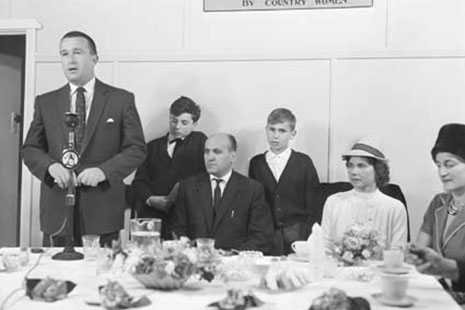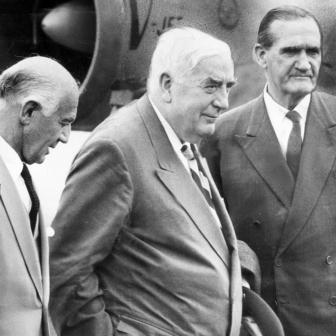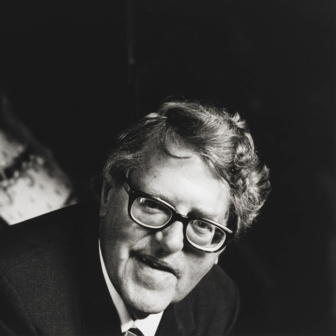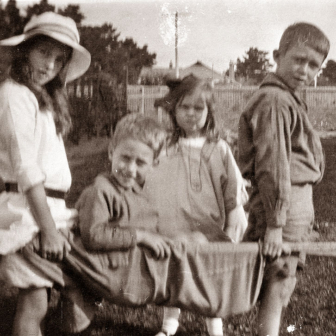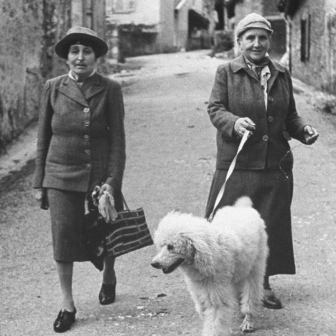I WONDER whether you have been as frustrated as I’ve been by the federal election campaign. The two major parties have offered us slogans rather than policies. Their statements on Australia’s future response to asylum seekers have been thinly disguised appeals to voters in a small number of marginal seats, most of them in western Sydney, who are said to be anxious about boat people. Labor and the Coalition have tried to soothe the fears of those voters because, according to psephological wisdom, only the party that wins their seats will be in a position to form government.
In deference to the vacillating and ill-informed voters of western Sydney, both the Coalition and Labor have promised they would halt the flow of asylum seekers arriving in Australia by boat. While the Coalition has advocated a return to temporary protection visas and extraterritorial processing on Nauru, Labor has talked in the vaguest of terms about a regional processing centre. Earlier, in a prelude to the election campaign, the Rudd Labor government ostensibly tried to discourage asylum seekers from making the journey to Australia, first by promoting an Indonesian Solution, and then, when that fell apart during the Oceanic Viking fiasco, by suspending the processing of protection visa applications by Afghani and Sri Lankan asylum seekers. That, too, was a concession to vox populi (or what is being taken for it) rather than sensible policy.
While Tony Abbott has directly appealed to the anxieties of sections of the electorate, Julia Gillard has condoned their fears.
Once more with an eye to the irrational fears of people in western Sydney and elsewhere, both major parties have allowed a debate about population policy to be confused with a debate about refugee policy – as if the paltry number of asylum seekers arriving by boat had been responsible for substantial population increases in outer metropolitan Sydney and Melbourne, and to a lesser extent in Perth and Brisbane. Or, to put it another way, as if stopping the boats were all that was needed to put a cap on net immigration, as if a cap on immigration would curb the expansion of Australia’s big cities, and as if the infrastructure in those cities wouldn’t deteriorate further if only they stopped growing.
For the past five years or so, at least since the failure of the Howard government to get its Migration Amendment (Designated Unauthorised Arrivals) Bill through parliament in 2006, it’s been clear that most Australians don’t necessarily support harsh measures designed to keep asylum seekers at bay. Shouldn’t we therefore have expected loud protests and a vigorous public debate in which the claims of Liberal and Labor Party politicians were scrutinised and challenged? No such debate eventuated – either when Labor began changing the rules earlier this year, or when the opposition made the slogan “Stop the boats” a centrepiece of its election campaign. Rather than taking on the fluff put out by the major parties by highlighting the rights of refugees and Australia’s moral and legal obligations, many refugee advocates have resorted to a tired refrain about the contributions refugees have made or could make to Australia.
Why have Gillard and Abbott gotten away with their campaign platitudes about boat people? Why have their “policies” not sparked a profound debate about refugee and asylum seeker policies?
The answer to these questions lies partly in the inward-looking nature of current political debate in Australia. It is a telling fact that there was almost no mention in this election campaign of foreign policy and Australia’s place in the world. But even more, it has to do with the absence of a pervasive historical narrative about Australian responses to refugees and asylum seekers. Without historical awareness, an informed debate about refugee and asylum seeker policy is not possible. Election campaigns are often characterised by promises made as if there were no tomorrow. The pronouncements on asylum seekers during this campaign were made as if there had been no yesterday.
That’s not only true for the past five weeks. Australia has never had a sustained and informed debate about its response to asylum seekers and refugees. There were promising starts – the last one in 2005–06, when Petro Georgiou, Judy Moylan, Bruce Baird, Judith Troeth and Russell Broadbent effected substantial changes to government policy.
But even those promising beginnings were hampered by myths – myths that have been powerful not least because of the absence of widely disseminated historical knowledge. According to the orthodox myth, Australians are inherently generous, and Australia has taken more than its fair share of refugees over the past sixty-five years. This myth has often been cited by the government of the day, irrespective of its party-political persuasion. Governments tend to promote patriotic histories – narratives about the past in which the nation’s achievements are highlighted and its people are credited with a range of positive attributes. According to the counter myth, Australians have been inherently racist and Australia’s contribution to alleviating the suffering of refugees has been paltry. Neither of these myths stands up to historical scrutiny.
When bemoaning the lack of an informed historical perspective, I am pointing the finger at politicians and journalists, and at historians. Immigration generally and Australian responses to refugees and asylum seekers in particular have been neglected fields in Australian history. Count the number of books written about the history of immigration in the past fifty years and compare it to the number of books written about Australian military history, political history, social history or cultural history. Or count the number of articles about immigration and refugee topics published in the main journal in the field, Australian Historical Studies. Or the number of PhD theses written about Australia’s response to refugees and asylum seekers. Or the space accorded to immigration and refugee issues in general histories of postwar Australia.
HOW COULD histories of previous Australian responses to asylum seekers and refugees throw a critical light on the present “debate” about asylum-seeker arrivals?
A discussion about the Coalition’s recent proposal to reintroduce temporary protection visas and detain asylum seekers on Nauru would have benefited from informed historical analyses of the Howard government’s asylum-seeker policies. TPVs were introduced two years before the Pacific Solution. They did not bring about a fall in the number of asylum seekers trying to reach Australia; instead they contributed to a change in the demographics: after their introduction, comparatively fewer single men and more women and children undertook the dangerous journey by boat.
The Pacific Solution was a response to a very specific situation: the arrival of the Tampa. It required the cooperation of at least three partners: Australia, a Pacific Island nation dependent on Australia (such as Nauru or Papua New Guinea) and New Zealand. Tony Abbott appears to have conveniently forgotten about New Zealand’s role in resettling a sizeable number of refugees from Nauru. Nearly all of those who were detained on Nauru, recognised as refugees but not resettled by New Zealand were resettled by Australia. An alarmingly large number of those detained on Nauru and not recognised as refugees came to harm after their return to Pakistan or Afghanistan.
In 2005, parliament passed the Migration and Ombudsman Legislation Amendment Act, which stipulated that the protection visa applications of asylum seekers be processed within ninety days of their arrival because of the overwhelming evidence that long-term detention was the main reason for the high incidence of mental illness among detainees and former detainees. On Christmas Island, it is possible to expedite the processing of protection visa applications. It would be extremely difficult to uphold the ninety-day processing time commitment on Nauru (or in East Timor, for that matter). On Christmas Island, detainees are released once they have been recognised as refugees and they have received their ASIO clearance. Past experience suggests that would not be the case on Nauru or in East Timor, and long periods of detention, with all the consequences documented during the Howard years, would again become the norm.
The more distant past could also serve to illuminate the present. It would be instructive to compare Tony Abbott and Julia Gillard’s pandering to irrational fears of boat people in the landlocked electorate of Lindsay with Bob Hawke’s pandering to the whims of voters in the Northern Territory and other sparsely populated parts of Australia who were afraid they would be overrun by Vietnamese boat people ahead of the 1977 federal election. It would be instructive to interrogate former prime minister Malcolm Fraser’s claim that he provided leadership in the debate about refugees and was thereby able to put a lid on the outpouring of xenophobic sentiment.
Or, to give yet another example, it would be instructive to think back to the late 1940s and the quite different intersections of debates about Australia’s population policy and Australia’s refugee policy. Then, of course, refugees were needed to boost the population. In 1949–50, some 100,000 refugees were resettled in one year. To put that figure into perspective: that’s as if today Australia resettled not 13,500 refugees per annum but twenty-three times as many: more than 300,000. At such a rate, Australia could resettle everybody from two of the most notorious refugee camps in Africa, Kakuma and Dadaab, in a bit over a year.
The late 1940s are interesting for another reason: then, as now, politicians distinguished between good (“genuine”) and bad refugees. The bad refugees, Asians who had sought refuge in Australia during the second world war, were targeted by the Labor government’s Wartime Refugees Removal Act 1949. The good refugees, blond and blue-eyed displaced persons, or DPs, from Lithuania, Latvia and Estonia, were welcomed with open arms. Then, as now, some of the displaced who would now be classified as refugees – the Jewish survivors of the Nazi concentration camps – jumped the queue, as it were, and came to Australia in privately chartered ships rather than courtesy of the International Refugee Organization. Then, as now, agitation against those boat people was informed by racist sentiment. Then, the government eventually caved in to the demand to curtail the immigration of Jews.
These three snippets could form part of a historical narrative. The content of the historical narrative I have in mind, however, would not be determined by the vagaries of today’s political debate. That is, it shouldn’t be a response to the need for specific historical analogies – not least because a historical narrative driven by the exigencies of current political debate and policy-making would be in danger of privileging a Whiggish perspective: one that views the past only through the lens of the present. I’m all in favour of histories that pay close attention to historical dead ends. I’ll therefore be more systematic: I suggest that the stories historians need to tell and disseminate about Australia’s response to refugees would usefully focus on six aspects:
1. We need to know more about the responses to different refugee-producing situations. We already know a lot about Australia’s responses to the refugee crisis triggered by Nazi Germany’s measures against Jews, to the displacement of millions of people during and in the aftermath of the second world war, to the Indochinese exodus in the late 1970s and to the more recent refugee crises in the Middle East and Central Asia. What is intriguing about the narrative commonly told now is the attention given to some events and some refugee groups, and the lack of attention to others. Official decisions not to admit refugees tend to rate hardly a mention: for example, the non-admission of Spanish refugees in the late 1930s, or the non-admission of so-called hard-core cases until the late 1950s, or the Whitlam government’s refusal to admit Vietnamese refugees in 1975. Little attention has been given to those who were not officially counted as refugees but were admitted partly because of the discrimination they feared or experienced, such as Anglo-Burmese after the military coup in 1961.
2. We need to know more about the changing definition of the term “refugee,” and, more generally, about how Australia’s criteria for distinguishing refugees from other prospective immigrants has evolved over time. Many of the displaced persons invited to Australia in the late 1940s and early 1950s would not have been admitted under the current regime.
3. We need to know more about the overlap between refugee policy and immigration policy (and that often also means population policy). Hardly anybody resettled in Australia before the late 1950s was considered foremost as a refugee. Rather, they were immigrants much like assisted-passage migrants from Britain, Italy, Germany or Holland.
4. We need to know more about Australia’s involvement with the international organisations dealing with refugee and asylum-seeker issues (including, most importantly, the International Refugee Organization, the Intergovernmental Committee for European Migration and its successor, the International Organization for Migration, and the United Nations High Commissioner for Refugees). Far too little is known about Australia’s contribution to the drafting of relevant legal instruments, such as the 1951 Convention and the 1967 Declaration on Territorial Asylum.
5. I would be surprised if many Australians, other than refugee law specialists, had ever heard of the 1967 Declaration on Territorial Asylum. We need to know more about Australia and the institution of asylum, about so-called unauthorised arrivals both in Australia and in its colonies and territories, and about how, over time, Australia developed procedures for the recognition of asylum seekers as refugees.
6. Finally, we need to know much more about the history of popular opposition to refugee arrivals as well as the history of refugee advocacy. We also need to have a better understanding of the interplay between concerted lobbying for or against the admission of refugees, public opinion and policy-making.
A narrative that includes those six elements would, I hope, be one that foregrounds the complexity of the past. It would also be one that emphasises continuities as well as ruptures. Current developments are not always variations of past developments. When discussing refugee policy it is particularly important to keep in mind the dramatic changes in the global context: the refugee regime at the beginning of the twenty-first century is radically different from that which prevailed before the formation of the UNHCR and the drafting of the 1951 Convention, or in fact before the end of the Cold War in the early 1990s.
While advocating that historians work towards an informed and widely told historical narrative about Australia’s response to refugees, I would like to caution against overly simplistic expectations, according to which “histories” are meant to save us from “memories.” The history that ought to inform public debate and policy-making is necessarily itself shaped by memories. It is always partial. Historians do not have unmediated access to the past, however rigorous their research methods may be. An appreciation of the making of memories and histories can therefore be as important as a thorough understanding of the past.
Tony Kushner, in his book, Remembering Refugees, claims that in the United Kingdom historians actively forgot refugees. His explanations go some way towards making sense of that forgetfulness in Australia. He writes that “the lack of attention given to refugees by historians… reflects the emphasis placed by many in the historical profession on continuity of presence rather than temporariness, flux and statelessness – the conditions that in many ways typify the experiences of refugees.” And: “Refugees or asylum seekers, lacking the fundamental requirements of home and homeland, have to be defined into shape. Those best suited to controlling their messiness and, more than anything, their inherent instability, it is deemed, are not historians but lawyers.”
I can think of three more possible explanations in the Australian context. They are probably more controversial than Kushner’s. First, most Australian historians are still wary of topics that require a truly interdisciplinary approach. It would be very difficult to write about the history of Australia’s response to refugees without dabbling in law, political science and sociology. Second, all the talk about the need for transnational histories notwithstanding, most Australian historians are still wedded to the national framework, which is unsuited to analysing most refugee issues. And finally, for all its critical engagement with the past, Australian history has a nationalist flavour. •
